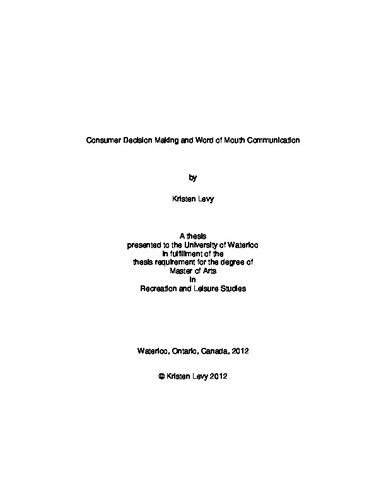UWSpace will be migrating to a new version of its software from July 29th to August 1st. UWSpace will be offline for all UW community members during this time.
Consumer Decision Making and Word of Mouth Communication
| dc.contributor.author | Levy, Kristen | |
| dc.date.accessioned | 2012-09-26 16:55:36 (GMT) | |
| dc.date.available | 2012-09-26 16:55:36 (GMT) | |
| dc.date.issued | 2012-09-26T16:55:36Z | |
| dc.date.submitted | 2012 | |
| dc.identifier.uri | http://hdl.handle.net/10012/7026 | |
| dc.description.abstract | Word of mouth (WOM) communication has been a form of additional information for consumers wishing to make a purchase decision where there was uncertainty, lack of knowledge or just a general desire for more information. The increased access and use of social media as well as anonymous opportunities for consumers to provide their reviews on products or services is changing how WOM is used and sought. There is little research on the impact and use of WOM with respect to consumer decision making in a recreation and leisure context. Much research has been focussed on retail experiences and more tangible outcomes. The purpose of this study was to explore the process consumers undertake to seek out, listen and engage in WOM communication when making service purchase decisions. This study took place in a municipality in York Region that offered swimming lessons to the public. Participants were chosen using convenience sampling methodology. 500 surveys were distributed with 301 returned surveys completed to some degree. Study participants were recruited from observers watching a swim class offered by a municipal recreation provider. The survey instrument asked participants to describe themselves in terms of their experience level with municipal recreation programs. It also included three scales relating to susceptibility to influence, self confidence and need for cognition. Participants were exposed to one of five scenarios – one control message contained no treatment information and four scenarios with treatment messages relating to self-confidence and perceived risk. Treatment group members received information suggesting either high and low levels of perceived risk with purchase and high and low levels of self-confidence with knowledge (regarding the purchase decision). Respondents in this study possessed a very high level of self confidence in their program selections; they knew where to find the information and also how to explore program options. Overall this seemed a very well informed and confident group. Results suggest that susceptibility to influence (t = 5.889, p = .000) and self confidence (t = -2.174, p = .037) influenced their search for WOM communication. Need for cognition did not influence the likelihood they would seek WOM communication (t = -1.098, p = .280). Together all three variables explained 50% of the variance (adjusted R2 = .505) in the dependent variable (likelihood they would seek out WOM to make the purchase). These results indicate that participants were more likely to seek WOM when they were susceptible to influence and when their self confidence levels were low. Results also suggest that consumers were open to on line sources of word of mouth communication. More than that, study participants were generally willing to trust online reviews from people who were not necessarily known to them. As a result, online reviews could greatly influence the program registration numbers. A key question for future research could focus on the role shared experience plays in the evolution of trust between strangers. Many of these respondents would trust the advice of others simply because they reported having shared experience. How far does this trust go? How much risk must be present before they hesitate to take advice from unknown individuals? What are the characteristics or traits that consumers look for when assessing the validity of the reviews. Word of mouth seems a very pervasive and resilient concept. This may be particularly important in situations characterized by risk. Additional research could further explore the concept of word of finger and its influence on the traditional concept of WOM communication. | en |
| dc.language.iso | en | en |
| dc.publisher | University of Waterloo | en |
| dc.subject | word of mouth | en |
| dc.subject | word of finger | en |
| dc.subject | consumer decision making | en |
| dc.subject | risk | en |
| dc.subject | susceptibility to influence | en |
| dc.subject | need for cognition | en |
| dc.subject | social media | en |
| dc.subject | self confidence | en |
| dc.subject | shared experience | en |
| dc.subject | social networks | en |
| dc.subject | trust | en |
| dc.subject | interpersonal preferences | en |
| dc.subject | tie strength | en |
| dc.title | Consumer Decision Making and Word of Mouth Communication | en |
| dc.type | Master Thesis | en |
| dc.pending | false | en |
| dc.subject.program | Recreation and Leisure Studies | en |
| uws-etd.degree.department | Recreation and Leisure Studies | en |
| uws-etd.degree | Master of Arts | en |
| uws.typeOfResource | Text | en |
| uws.peerReviewStatus | Unreviewed | en |
| uws.scholarLevel | Graduate | en |

